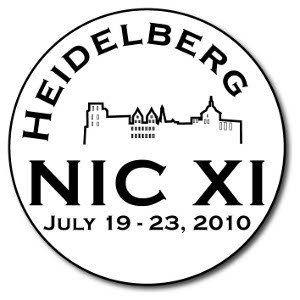11th Symposium on Nuclei in the Cosmos (NIC XI)
Heidelberg, 19-23 July 2010
Scientific rationale
Considerable progress has recently been made towards answering some of the fundamental
questions in nuclear astrophysics. For example, the development of multidimensional supernova
models opened a very promising path towards finally understanding the explosion mechanism(s) of
supernovae, and improved treatment of weak interaction rates has lead to major advances in
predictions of explosive nucleosynthesis. Owing to the availability of three-dimensional
hydrodynamical model atmospheres of cool stars as well as non-local thermodynamical equilibrium
line formation calculations and improved atomic data for an increased number of elements, these
predictions can now be compared with more accurate abundances of extremely metal-poor and
hence old stars, in which e.g. the products of Big Bang and neutron-capture nucleosynthesis can be
observed. On the experimental nuclear physics side, cross-section measurements at Gamow peak
energies have improved our understanding of the hydrostatic burning phases of stars.
In the next few years, major drivers of the progress of the field will be new nuclear physics
facilities. The Radioactive Ion Beam factory (RIB) at RIKEN in Japan is already operational, and
the first results relevant to nuclear astrophysics will be presented in Heidelberg. Furthermore,
the Facility for Antiproton and Ion
Research (FAIR) will soon be built in Darmstadt, and the
Facility for Rare Isotope Beams (FRIB)
will be built in East Lansing (Michigan, USA). These facilities will allow to study many of
the unstable nuclei located in the r-process path for the first time in the laboratory, and hence they
can be considered as "r-process factories". Consequently, our understanding of the
nucleosynthesis of the heavy elements will improve dramatically in the near future. Nuclei in the
Cosmos XI in Heidelberg will be important for defining priorities for the nuclear astrophysics
programs to be carried out at the new facilities.
In Germany, many initiatives related to nuclear astrophysics have recently been started. For example, the Helmholtz International Center for FAIR (HIC4FAIR) and the ExtreMe Matter Institute (EMMI) have been founded. In Munich, one research area of the Excellence Cluster "Origin and Structure of the Universe" is concerned with investigations of the enrichment of the Universe with heavy elements. The Helmholtz Graduate School for Hadron and Ion Research (HGS-HIRe) is aiming at educating the next generation of researchers working on hadron and ion research, including nuclear astrophysics. Germany, and in particular Heidelberg, being involved in many of these activities, is therefore an excellent place to host Nuclei in the Cosmos XI.

